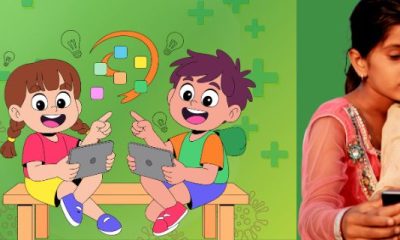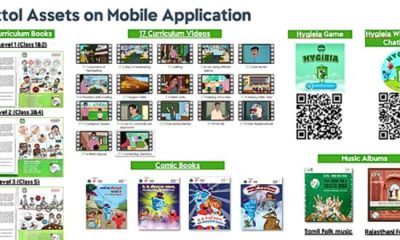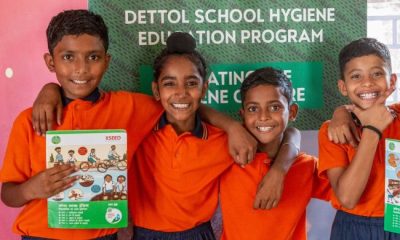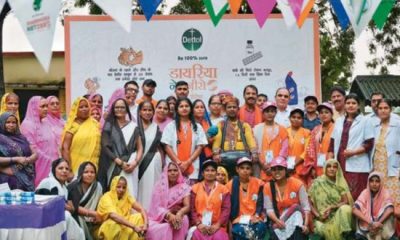Highlights
- MDM scheme served about 9.17 crore children in India in 2019
- COVID-19 pandemic shut schools, government made provisions to home deliver
- Anganwadi workers visit homes every 25 days to deliver 2 kg wheat and 1 kg
New Delhi: With the ongoing COVID-19 pandemic, United Nations’ State of Food Security and Nutrition in the World report, forecasts that the coronavirus could push over 132 million more people into chronic hunger by the end of 2020. This figure will be over and above the existing 690 million undernourished people, the study says. This setback further weakens the possibility to achieve the Sustainable Development Goal Two, which aims for zero hunger by 2030, the report concludes. Among various government schemes on food and nutrition, an important aspect of helping India’s children meet their nutritional needs, is the government’s flagship Mid-Day Meal (MDM) programme.
The MDM Scheme has played a significant role in increasing enrolment and improving attendance of children in the schools, but it has far deeper implications – as it is one of the crucial ways to ensure the nutritional security of children. As per the government data, in the year 2018-19, MDM scheme served about 9.17 crore children in 11.35 lakh schools across the country. However, the scheme has faced massive challenges, when the COVID-19 lockdown was announced and schools and Anganwadis were shut down.
Union Minister of Human Resource Development (HRD), Ramesh Pokhriyal Nishank had announced when the lockdown was imposed, that the mid-day meals will be provided to students even during the lockdown and the subsequent summer vacations.
Mr Pokhriyal had also announced an increased allocation for the smooth distribution of the mid-day meals with an additional expenditure of about Rs 1,700 crores.
He further said that in wake of COVID-19, the annual central allocation of cooking cost (or procurement of pulses, vegetables, oil, spices and fuel) under the mid-day meal scheme has been enhanced to Rs 8,100 crore from Rs 7,300 crore allocated for April 2020, an increment of nearly 11 per cent.
While the top-level has made the necessary arrangements and allocation for the smooth and uninterrupted nutrition of the children via mid-day meals. What is the status on the ground?
MDM On Ground Implementation: Beneficiaries And Experts Speak:
Antaryami Dash, Nutrition Head from Save The Children Foundation, tells NDTV that while the governments are doing their job and forming policies, the implementation powers remain at the district level.
The HRD Ministry in order to ensure each child gets the meal that they are entitled to give all the states and districts across the nation three options – either serve hot meals to their doorstep, provide them monthly ration kits or provide them the money conversions also known as Food Security Allowances. Let’s assume a mid-day meal costs about Rs. 10-15 a day for a kid, so for a month it will be approximately Rs 300, so each beneficiary is entitled to this sum. But the entire implementation of MDM in this condition, depends upon the individual setup of each state. So, if the collector, state authorities are on their toes, they might do it well, if they want to. I’m not saying throughout the state’s children are not receiving MDM, I’m sure they are receiving in some places but there will be inter-district variations as well as intra-block variation. Everything comes down to their administration and their will and zest, that’s just how Indian development programmes function on the ground.
Mr Dash said that through Save The Children Foundation’s concurrent assessment across 15 states, covering 7,235 respondents, they found that around 40 per cent of the eligible children have not received the mid day meals during this lockdown. He further said that these 15 states and UTs, include Assam, West Bengal, Bihar, Jharkhand, Odisha, NCT of Delhi, Jammu & Kashmir, Uttar Pradesh, Madhya Pradesh, Maharashtra, Rajasthan, Karnataka, Andhra Pradesh, Telangana and Tamil Nadu.
Through another non-profit organisation, Roti Abhiyan, NDTV reached out to some children, who are beneficiaries of MDM, belonging to a few of the above-mentioned state, to find out more about the on-ground situation of implementation.
Also Read: India Observed A Decline Of 60 Million Undernourished People In 2019, Reveals The Latest UN Report
In Delhi, 8-year-old Gudiya is a resident of Lal Gumbad Camp, near Panscheel Park where she lives in a five member family. Before lockdown, her mother used to work as a domestic help and her father worked as a delivery boy in Zomato, however at present, both of them are out of work. Gudiya and her siblings, all older than her, study in a government school, where they were provided with MDM. Her mother told NDTV that she hasn’t received any mid-day meals or compensation,
Due to certain reasons, I do not have a ration card and we have not received any money or MDM since the lockdown. We are struggling to make ends meet. I asked in my kids’ school about the MDM but our area is sealed as it is a containment zone, so we have never received anything. Even my sister who lives in a camp near Rohini and has 2 children, says that they haven’t received MDM or money for MDM.
On the other hand, 7-year-old Rishi from Bihar’s holy town of Gaya said that they received their mid-day meal in the month of April which stopped by May. His mother told NDTV,
We did get the MDM in April, consisting OF eggs and even milk but by May, our school authority told us that a few people tested positive from their MDM team so they have stopped cooking food and will send us money. We are waiting for money but until today I haven’t received any money.
11-year-old Paulimi from Durgapur in West Bengal has received her mid-day meals, her mother said,
Paulimi received her school meals until June and for the month of June we received Rs 350 in my husband’s account and we were told by her principal that it’s for her lunch. In July, we have received ration, as the principal of his school told us that this month they’re distributing rations. I asked them why the variations, so they said that they want to provide in whichever way it is convenient for them each month.
11- year-old, Vijay Kumar from Badaun district of Uttar Pradesh, is the son of a daily wager. Vijay’s mother Meena told NDTV,
It is very tough time for poor families like ours and our financial condition does not allow us to feed our children fruits, milk or other nutritious food items. Ever since the lockdown, my son is not getting the nutritious meals that he used to get in school. The distribution of dry ration and security compensation by the state government is yet to be provided to us. The security compensation and dry ration will prove to be very beneficial in our lives as it will help to feed the entire family.
According to nutrition experts, for a large chunk of the children of India mid-day meal is their only source of nutrition in the day, therefore the importance of mid-day meals for children cannot be undermined. Talking to these families, it is a mixed record, wherein many places children are neither receiving their mid-day meals (MDM), nor any Take Home Rations (THR), or even reimbursement in cash.
According to UN’s World Food Programme (WFP), even though MDM is the best route to food and nutrition security for children, the government is issuing extra food rations and inclusion of pulses for the next five months to families under PMGKY (Pradhan Mantri Gramodaya Yojana) during COVID lockdown. This will be helpful to meet their food needs. A spokesperson from WFP told NDTV,
All in all, most of the States and Union territories in the country are implementing the mid-day meal in line with the above-mentioned government guidance. For instance, in Odisha, where we work with the state government, students were distributed dry ration for 3 months in advance through Public Distribution System outlets. Coupon with unique ID was assigned to them and the students or their parents would draw rations (rice and other commodities) from Fair Price Shops (FPS) on the production of coupons. The coupons will to be later reconciled to settle the accounts with the FPS owners.
However, supporting Mr Dash’s point, WFP also highlighted that fact that India is a large country and the quality of implementation may vary from State to State and even within a State, from district to district. The spokesperson added,
WFP India has been tracking the implementation of both the Mid-day meal scheme as well as the food component of the Integrated Child Development Services (ICDS) scheme at State level since the beginning of the pandemic through media reports, government websites and telephonic calls to government counterparts and development partners. Media reports about the situation in the state of Bihar, where failure to implement delivery of mid-day meals in-line with the government guidance, led the children in certain districts to start waste collection or begging to survive, was unnerving.
Mid-Day Meals In Urban Areas Vs Rural Areas
Another important factor, which is a significant on-ground reality for distributing the midday meal, is the disparity in urban and rural areas. While in the urban areas, the distribution of MDM has remained difficult and negligible, rural areas have not really faced major challenges until now.
NDTV reached out to Nisha an ASHA worker from the village Majawada near Jodhpur, Rajasthan. Nisha told us that all the ASHA workers, Anganwadi workers and other volunteers associated with the Anganwadis and schools are responsible for home delivering ration kits for the children. She explains,
We have a list of all the children who attend Anganwadi and schools. We get the ration kits consisting 2 kg wheat and 1 kg Chana Dal and we are all responsible for delivering these kits to each and every student in every 25 days.
Another ASHA worker, Shanta Garg from Dulawato Ka Guda village in UP, tells NDTV that they are not just responsible for delivering mid-day meals, but also to check children’s growth. She said,
In order to ensure the children are getting optimum nutrition, we also check their weight, height and any symptoms for COVID disease when we visit them to deliver the ration kits.
While the system seems to run smoothly in rural areas, in the national capital, the MDM has not been served at all, says Amrita Johri from Roti Abhiyan, a Delhi-based NGO. She said,
NGO Mahila Ekta Manch filed a Public Interest Litigation in Delhi High court, in which IT sought directions to the Delhi government to provide cooked midday meals or food security allowances to eligible children during the COVID-19 lockdown when schools in the national capital are shut.
Also Read: Fighting COVID-19: Plant-Based Diet Can Boost Resistance Against Invading Pathogens, Say Experts
The Delhi government had on June 30 told the bench that funds for providing mid-day meals to children in its schools were yet to be received. However, The Centre informed the Delhi High Court on Monday that it has released over Rs 27 crore to the AAP government as recurring central assistance under the mid-day meal (MDM) scheme. The counsel appearing for the Centre said Rs 9 crore was released on April 29 and over Rs 18 crore was released on May 1 and sought time to file an affidavit on it.
While this has turned into a political ‘he said-she said’, at the end of the day it Is the children who are suffering without the meals. How are we to achieve the Zero Hunger target by 2030 is this continues? It is no secret how big of a crisis malnutrition in India is.
Mr Dash explained his opinion on the disparity between urban and rural areas, as he said that the problem mainly is not being able to reach the beneficiaries due to COVID-19.
Earlier, even us the people working with non-profits could easily visit the children on the ground. But now we also have to monitor and maintain records on telephones due to the coronavirus. Moreover, most of the organisations are not able to reach people who are distressed, in person. But when it comes to MDM, rural areas, until now, were doing better with MDM, as Anganwadi workers can easily track and visit these households which they do on a routine basis. The lockdown instructions were followed and adhered to in the urban areas more than the rural areas.
He further added that in urban areas, issues being faced by administrations were that either some were the children of migrant workers who have either gone back or are unable to be tracked. But the main issue is that most urban areas, according to Mr Dash, are containment zones, hotspots, where curfews and lockdowns are frequently happening.
So it is difficult to go there and distribute mid-day meals because these are locked up places, he added.
Also Read: Opinion: Nourishing The Undernourished In Quarantine During COVID-19 Times
However he said that rural areas may face issues now as gradually, we are seeing the prevalence of COVID spreading towards the rural areas.
I think they will face the problem now because initially to start with, from April to June, it was only the urban areas which were the epicentre of the issues. But due to the migrant population returning home, as one of the important factor, the virus is spreading more and more in the rural areas and we fear that children might face issues there, beginning now. However, I’m pretty positive that rural areas still are easier to manage as compared to urban areas.
What Can Be Done To Ensure Mid-Day Meals And COVID-19 Pandemic?
Soha Moitra, Regional Director, Child Rights and You (CRY), talked to NDTV about the MDM programme ‘been badly hit’. She asserts that MDM is a crucial nutritional support programme for many school-going children to supplement their dietary needs to combat malnutrition.
Unavailability of a freshly cooked nutritious meal might leave a long-term effect on a child’s development. Even if the distribution of dry ration and food security compensation is the new substitute to MDM, there is a need to develop a monitoring system at panchayat level to ensure that marginalised families are actually benefitted with the same.
Mr Antaryami Dash says that the country cannot afford to see an increase in an already huge burden of child malnutrition and micronutrient deficiencies among children.
Thus, further realignment is required for MDM service delivery strategies with clearly more focus in urban areas to increase the coverage, Mr Dash asserts.
WFP highlights that with the on-going food support, what is missing is the diversification of food rations and inclusion of cash for women to buy vegetables and eggs can provide further support.
Given such a huge migrant crisis and an ongoing pandemic, it will be crucial to closely monitor the food and nutrition situation among vulnerable communities and provide appropriate responses, if needed. The values and advantages of Mid-Day meals are multiple and immense, and we trust that these programmes will restart immediately, when the schools reopen, the WFP spokesperson said.
Meanwhile, in order to ensure the mid-day meals are received by every child entitled to it in urban areas, WFP suggests that the School Management Committee (SMC) and/or Parents Teacher Associations (PTA) in these times will need to step up and take control of the monitoring.
NDTV – Dettol Banega Swasth India campaign is an extension of the five-year-old Banega Swachh India initiative helmed by Campaign Ambassador Amitabh Bachchan. It aims to spread awareness about critical health issues facing the country. In wake of the current COVID-19 pandemic, the need for WASH (Water, Sanitation and Hygiene) is reaffirmed as handwashing is one of the ways to prevent Coronavirus infection and other diseases. The campaign highlights the importance of nutrition and healthcare for women and children to prevent maternal and child mortality, fight malnutrition, stunting, wasting, anaemia and disease prevention through vaccines. Importance of programmes like Public Distribution System (PDS), Mid-day Meal Scheme, POSHAN Abhiyan and the role of Aganwadis and ASHA workers are also covered. Only a Swachh or clean India where toilets are used and open defecation free (ODF) status achieved as part of the Swachh Bharat Abhiyan launched by Prime Minister Narendra Modi in 2014, can eradicate diseases like diahorrea and become a Swasth or healthy India. The campaign will continue to cover issues like air pollution, waste management, plastic ban, manual scavenging and sanitation workers and menstrual hygiene.
[corona_data_new]





























